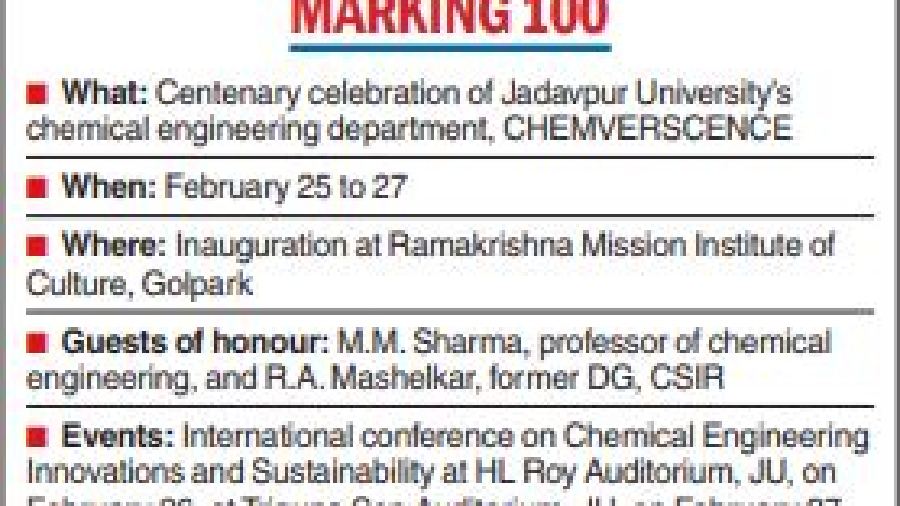A department of Jadavpur University that is much older than the university itself will celebrate its centenary from Saturday.
The chemical engineering class was born out of a movement that believed in propagating an emergent nationalist spirit through imparting of literary, scientific and technical education. That was in 1921, even before the UK had such a department.
After a two-year Covid-forced delay, the department will commemorate its centenary, CHEMERVESCENCE, from February 25 to 27.
How it started
The establishment of the department, the first of its kind in India, stood out because the purpose was not just imparting scientific and technical education, but also developing entrepreneurs who could challenge the hegemony of the British.
Hiralal Roy, a student of Bengal National College under the National Council of Education (NCE), who founded the department, took advice from Acharya Prafulla Chandra Ray to frame the syllabus.
Ray, fired by nationalistic zeal, modelled the syllabus on what was taught at the Massachusetts Institute of Technology, US, said Asit Kumar Mitra, a former head of the department (from 1996 to 1998).
The chemical engineering course started with around 10 students in 1921. It was taught on different premises in and around Maniktala before shifting to Jadavpur in 1924. The present building came up in the early 1940s.
When the Bengal government enacted legislation to establish Jadavpur University in 1955, the NCE transferred all its property and teachers to the fledgling university and the chemical engineering department — along with other departments — came under JU.

Pre-Independence
After passing Intermediate in Science from the National College in 1910, Roy went to Harvard University, US, to study chemistry as an undergraduate student.
“When he returned from Harvard in 1913, he understood chemical engineering and chemistry are two different subjects. Since the council came into being from a nationalistic spirit, Roy imbibed this idea and saw chemical engineering as a tool to develop indigenous entrepreneurs,” said Mitra, who graduated from the department in 1961.
Aurobindo Ghosh was the first principal of Bengal National College.
Roy was joined by Baneswar Dass, who studied chemical engineering in the University of Illinois, US, in running the department. Roy then went to Berlin to pursue a doctorate in chemical engineering. When he returned in 1926 and joined the department at JU, student intake peaked.
Anti-national? No
Sudakshina Ghosh, Roy’s granddaughter, said a study of the chemical engineering department’s history would reveal its contribution to nation-building.
“These days, we hear a lot about ‘Make in India’. My grandfather Hiralal Roy and his students demonstrated what ‘Make in India’ means. He returned from Harvard to serve the institution that sent him there and for his desire to carry out his patriotic mission. The department, the campus, carries this legacy,” said Ghosh, who graduated in chemistry from JU.
Many former students of the department lamented attempts by the Right-wing ecosystem to portray JU as a cradle of anti-national ideas.
Fillip to industry
Sachindra Prasad Saha, of the 1935 batch, launched The Bharat Battery Mfg. Co. the same year. The company was a pioneer in making commercial battery plates based on Saha’s process developed in labs.
Around the same time, Jadavpur Soap Works was established by a student who learned the technique of shaving soap sticks at the department.
“In those days, students were infused with this spirit of being entrepreneurs who could be self-reliant and employ others,” said Dwipen Ghosh, of the 1965 batch.
Anxiety and hope
Many former students said this brilliant run suffered a jolt because of the Naxalite movement in the late 1960s.
In December 1970, then JU vice-chancellor Gopal Chandra Sen was murdered on the campus at the height of the movement.
“Like many other departments, our department, too, was in the doldrums and chaos prevailed,” said Ranjit Chakravorty, who graduated in 1961.
As disruption ebbed, academic activities resumed, but things were different. The industry ecosystem that helped the department thrive changed dramatically since the 1980s.
Bengal ceased to be the hub of industry. Gujarat and Maharashtra emerged as hubs of chemical and allied industries.
Debashis Ghosh, national centenary advisory committee coordinator, said: “We hope industry-academia interactions (lined up during the celebrations) will give us a direction on how we could make ourselves more relevant.”
JU pro-VC Chiranjeeb Bhattacharya, an alumnus of the department, said: “The department’s rich heritage embodies the enlightened path of technical education in Bengal.”
The department now has 118 BTech seats.






